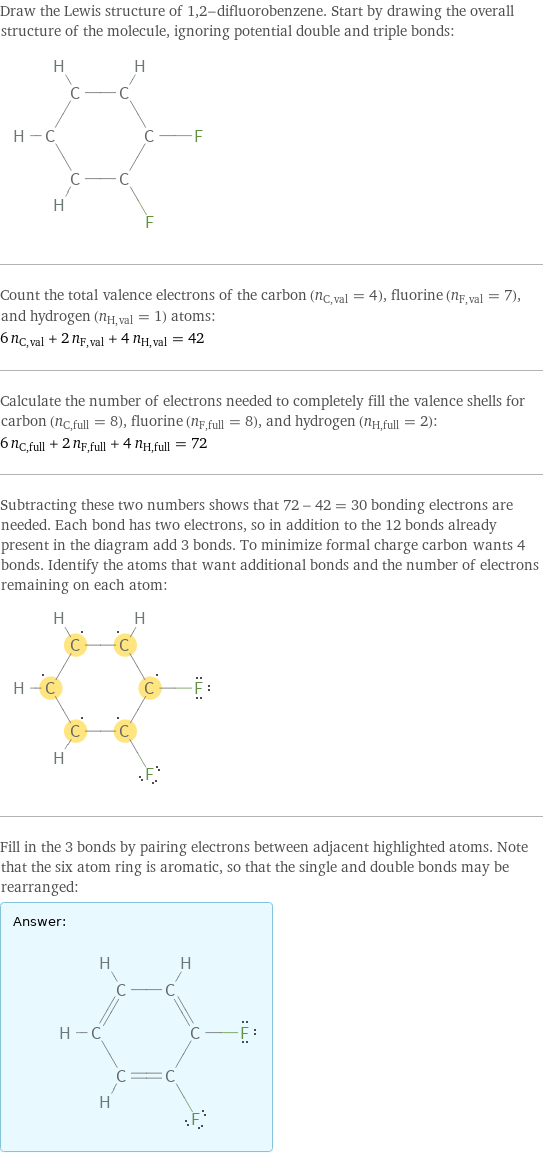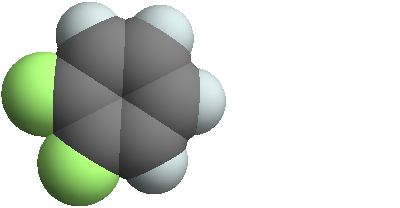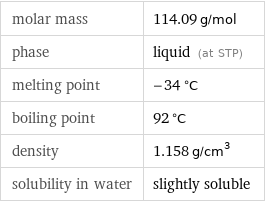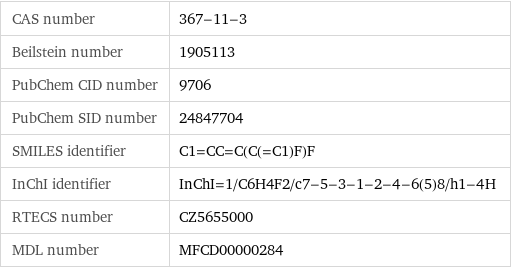Input interpretation

1, 2-difluorobenzene
Chemical names and formulas

formula | C_6H_4F_2 name | 1, 2-difluorobenzene alternate names | benzene, 1, 2-difluoro- | benzene, o-difluoro- | o-difluorobenzene | ortho-difluorobenzene mass fractions | C (carbon) 63.2% | F (fluorine) 33.3% | H (hydrogen) 3.53%
Lewis structure

Draw the Lewis structure of 1, 2-difluorobenzene. Start by drawing the overall structure of the molecule, ignoring potential double and triple bonds: Count the total valence electrons of the carbon (n_C, val = 4), fluorine (n_F, val = 7), and hydrogen (n_H, val = 1) atoms: 6 n_C, val + 2 n_F, val + 4 n_H, val = 42 Calculate the number of electrons needed to completely fill the valence shells for carbon (n_C, full = 8), fluorine (n_F, full = 8), and hydrogen (n_H, full = 2): 6 n_C, full + 2 n_F, full + 4 n_H, full = 72 Subtracting these two numbers shows that 72 - 42 = 30 bonding electrons are needed. Each bond has two electrons, so in addition to the 12 bonds already present in the diagram add 3 bonds. To minimize formal charge carbon wants 4 bonds. Identify the atoms that want additional bonds and the number of electrons remaining on each atom: Fill in the 3 bonds by pairing electrons between adjacent highlighted atoms. Note that the six atom ring is aromatic, so that the single and double bonds may be rearranged: Answer: | |
3D structure

3D structure
Basic properties

molar mass | 114.09 g/mol phase | liquid (at STP) melting point | -34 °C boiling point | 92 °C density | 1.158 g/cm^3 solubility in water | slightly soluble
Units

Liquid properties (at STP)

density | 1.158 g/cm^3 vapor pressure | 57 mmHg (at 25 °C) refractive index | 1.443
Units

Thermodynamic properties

specific heat capacity c_p | liquid | 1.394 J/(g K) molar heat capacity c_p | liquid | 159 J/(mol K) specific heat of formation Δ_fH° | gas | -2.575 kJ/g | liquid | -2.892 kJ/g molar heat of formation Δ_fH° | gas | -293.8 kJ/mol | liquid | -330 kJ/mol specific entropy S° | liquid | 1.951 J/(g K) molar entropy S° | liquid | 222.6 J/(mol K) molar heat of vaporization | 32.2 kJ/mol | specific heat of vaporization | 0.282 kJ/g | molar heat of fusion | 11.05 kJ/mol | specific heat of fusion | 0.0968 kJ/g | critical temperature | 566 K | (at STP)
Chemical identifiers

CAS number | 367-11-3 Beilstein number | 1905113 PubChem CID number | 9706 PubChem SID number | 24847704 SMILES identifier | C1=CC=C(C(=C1)F)F InChI identifier | InChI=1/C6H4F2/c7-5-3-1-2-4-6(5)8/h1-4H RTECS number | CZ5655000 MDL number | MFCD00000284
NFPA label

NFPA label

NFPA health rating | 1 NFPA fire rating | 3 NFPA reactivity rating | 0
Safety properties

flash point | 2.222 °C

DOT hazard class | 3 DOT numbers | 1993
Toxicity properties

RTECS classes | other